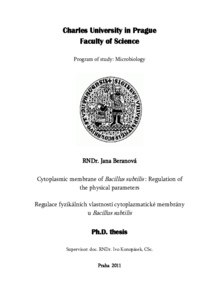Cytoplasmic membrane of Bacillus subtilis Regulation of the physical parameters
Regulace fyzikálních vlastností cytoplazmatické membrány u Bacillus subtilis
dizertační práce (OBHÁJENO)

Zobrazit/
Trvalý odkaz
http://hdl.handle.net/20.500.11956/34718Identifikátory
SIS: 87677
Kolekce
- Kvalifikační práce [19588]
Autor
Vedoucí práce
Oponent práce
Branny, Pavel
Holoubek, Aleš
Fakulta / součást
Přírodovědecká fakulta
Obor
-
Katedra / ústav / klinika
Katedra genetiky a mikrobiologie
Datum obhajoby
5. 4. 2011
Nakladatel
Univerzita Karlova, Přírodovědecká fakultaJazyk
Angličtina
Známka
Prospěl/a
Klíčová slova (česky)
membrane fluidity, desaturase, BacillusBacillus subtilis, modelová Gram-pozitivní bakterie, uplatňuje při adaptaci své membrány k nízkým teplotám dva odlišné mechanismy: 1) Při dlouhodobé adaptaci k nižším teplotám dochází ke zvýšení poměru anteiso/iso-větvených mastných kyselin v membránových lipidech. 2) Po náhlém poklesu teploty je indukována syntéza desaturázy (Des), proteinu, který v aerobních podmínkách desaturuje řetězce mastných kyselin v lipidech cytoplazmatické membrány. Transkripce genu des, kódujícího desaturázu mastných kyselin, je indukována zvýšením uspořádanosti membrány. Pro indukci transkripce genu des je nezbytná účast dvoukomponentového systému DesK-DesR. V této práci jsem sledovala, jak kultivační podmínky ovlivňují mechanismus adaptace membrány B. subtilis k nízkým teplotám. Použity byly metody fluorescenční spektroskopie, analýza mastných kyselin, diferenciální skenovací kalorimetrie a metody molekulární biologie. V první části práce jsem se zabývala vlivem složení kultivačního media na chemické složení a biofyzikální parametry cytoplazmatické membrány B. subtilis během růstu v optimální (40 řC) a suboptimální (20 řC) teplotě. Srovnávala jsem komplexní medium s glukózou bohaté na živiny a dvě média minerální obsahující buď glukózu nebo glycerol jako zdroj uhlíku. Získaná data jasně ukazují zásadní vliv složení...
Bacillus subtilis, a model Gram-positive soil bacterium, employs two distinct mechanisms in its membrane adaptation to low temperature: 1) Long-term adaptation to suboptimal temperature is accomplished by increasing the ratio of anteiso- to iso-branched fatty acids in the membrane lipids. 2) After a sudden temperature decrease, the oxygen-dependent fatty acid desaturase (Des) is induced which desaturates fatty-acyl chains incorporated in membrane lipids. The transcription of the gene encoding desaturase, des, is activated by the decrease of the membrane order, via two- component system DesK-DesR. In this work, I studied the influence of cultivation conditions on the mechanisms of B. subtilis membrane adjustments for a low temperature employing fatty acid analysis, fluorescence spectroscopy, differential scanning calorimetry and methods of molecular biology. In the first part of this work, I examined the impact of the cultivation medium on the composition and biophysical features of the B. subtilis cytoplasmic membrane during growth under the optimal (40 řC) and suboptimal (20 řC) cultivation temperature. I compared the nutrient-rich complex medium containing glucose and the mineral medium supplemented with either glucose or glycerol. The results obtained showed the crucial importance of medium...
